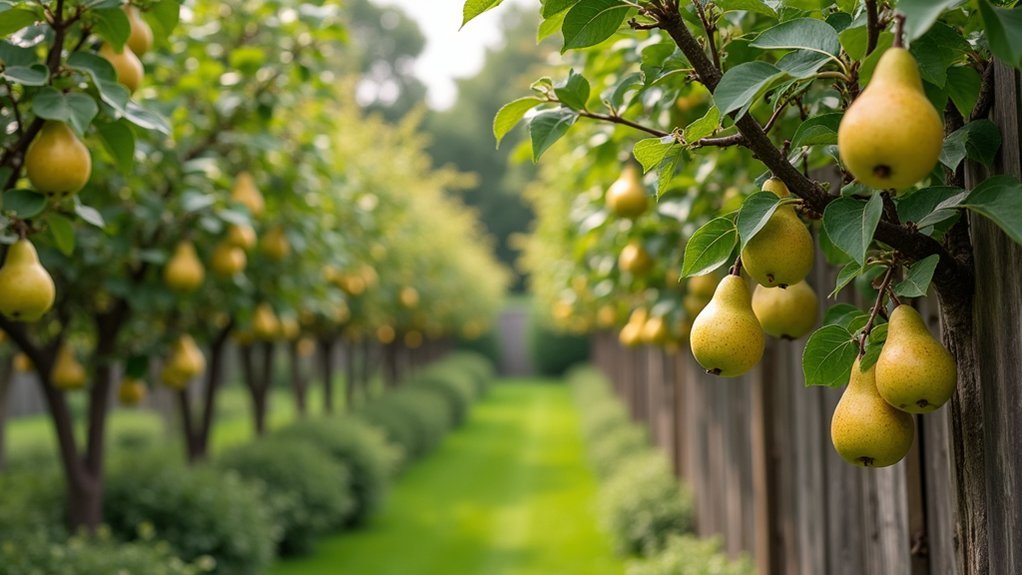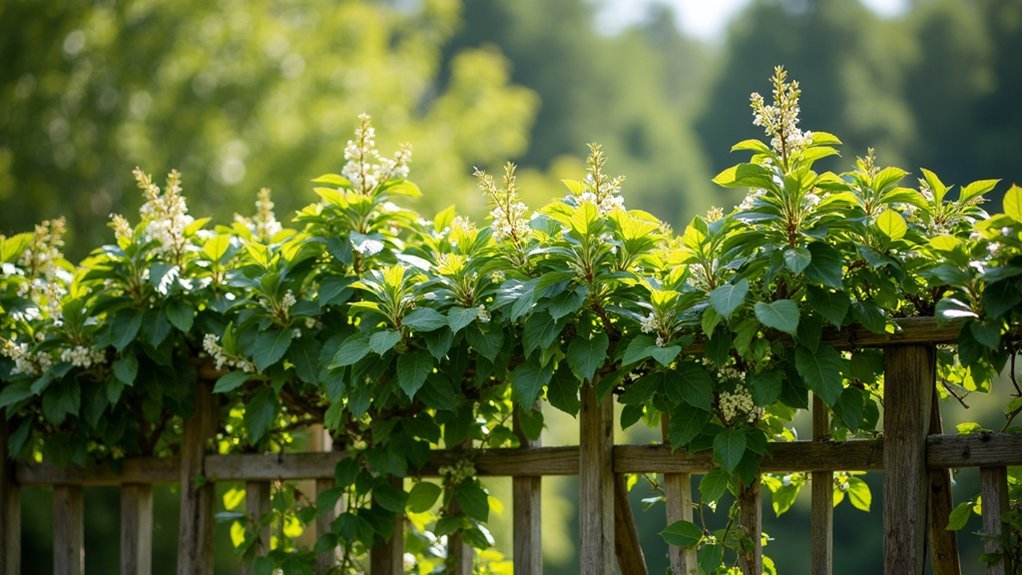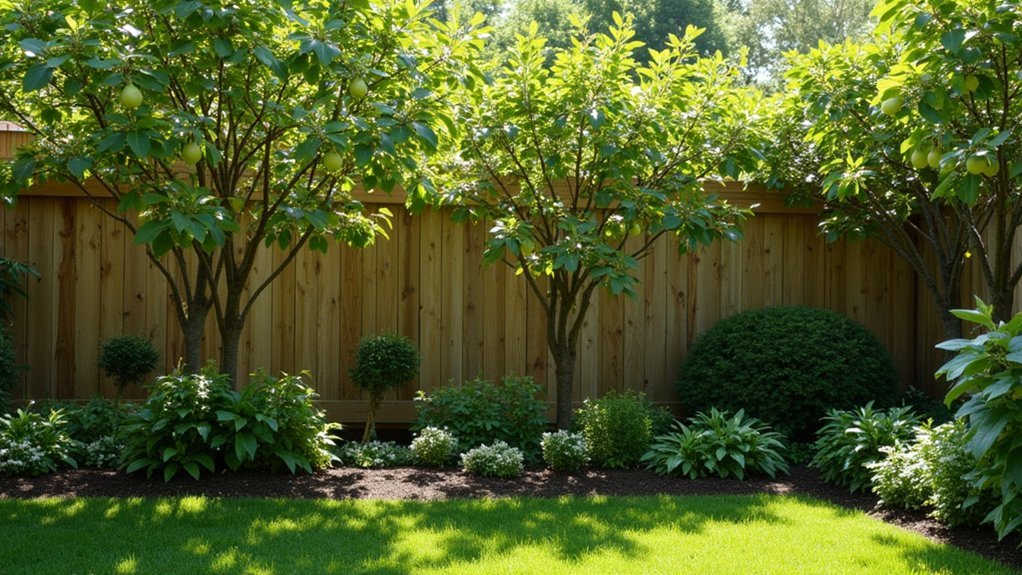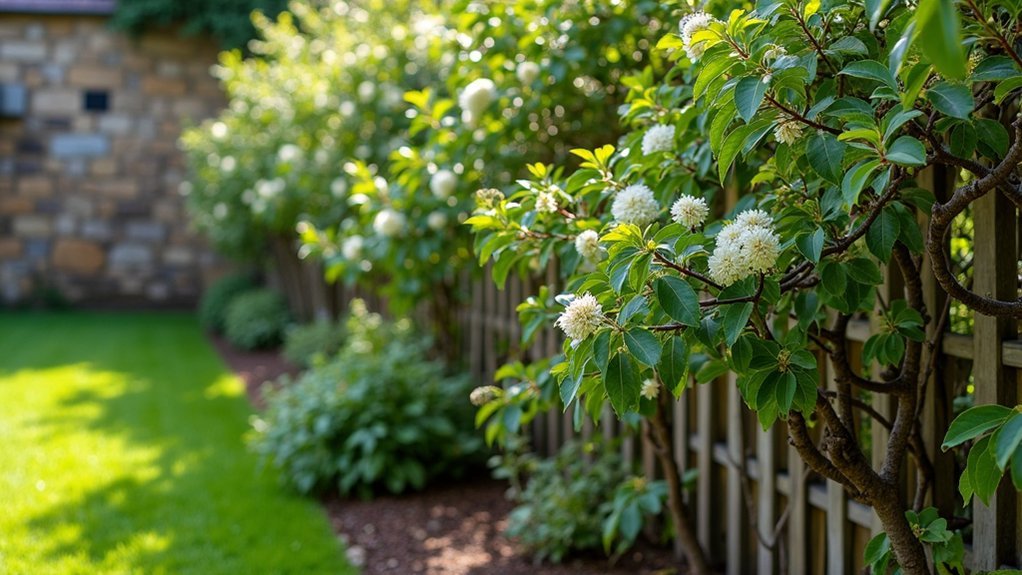Espalier pear trees create elegant living barriers with minimal space. Choose self-pollinating varieties like Kieffer for standalone screens or mix Bartlett and Magnus for diversity. Install sturdy trellises with galvanized wire spaced 14-18 inches apart. Prune regularly, cutting side-shoots to three leaves above basal clusters in summer. Train branches horizontally to maximize coverage while maintaining 4-6 inches from walls for air circulation. These five techniques will transform your ordinary boundary into a fruitful, architectural feature.
Selecting the Right Pear Varieties for Living Barriers

Four exceptional pear varieties stand out when creating living barriers through espalier techniques. Kieffer leads the pack with its vigorous growth and self-pollinating capability, making it perfect for standalone fruit tree barriers. Magnus, Bartlett, and Harrow’s Delight complete your selection options, each offering unique flavors and climate adaptability.
When selecting pear trees for your espalier project, consider their growth habits. Kieffer and Bartlett feature upright growth patterns ideal for narrow spaces while still creating effective 6-foot-tall screens that allow light and air circulation.
For maximum visual appeal and extended harvests, incorporate multiple varieties in your barrier design. This approach enhances biodiversity while providing diverse fruiting options throughout the growing season—turning your functional barrier into a productive, beautiful landscape feature.
Creating an Effective Support System for Espalier Fences
Once you’ve selected the perfect pear varieties for your living barrier, you’ll need a robust support system to train them properly. A sturdy trellis forms the backbone of your espalier project, supporting branches as they grow into horizontal tiers.
The foundation of any successful espalier lies in its support structure—without it, even the finest pear varieties cannot achieve their intended form.
- Install galvanized wire (12-gauge or heavier) spaced 14-18 inches apart vertically to create the framework where you’ll train your branches.
- Set posts 8 feet apart to anchor your wires, ensuring they’re strong enough to support mature trees and their fruit load.
- Maintain tight tension in your wires to prevent sagging as your espalier develops.
- Check your support system regularly, making adjustments as needed to accommodate growing branches.
Consider adding decorative elements to your trellis design, combining functionality with aesthetic appeal for your living barrier.
Pruning Techniques to Maintain Barrier Density

Regular pruning stands at the heart of successful espalier maintenance, especially when your pear trees serve as a living barrier. During summer, prune them back by cutting side-shoots to three or four leaves above the basal cluster, encouraging bushy growth that fills gaps between the first tier and second tier.
Once you’ve established your final tier, remove replacement central shoots and thin fruiting spurs after 7-8 years to maintain vigor.
Winter renovation requires careful assessment—remove dead wood and restore balance by cutting excessive growth. This rejuvenates dormant buds and maintains uniform density across all tiers.
Complete all espalier pruning before the first frost to prevent damage to new growth. This disciplined approach guarantees your pear barrier remains compact, productive, and provides the dense screening you desire year-round.
Training Branches to Maximize Coverage and Privacy
Creating a dense, private barrier with espalier pears requires strategic branch training in addition to the pruning we’ve discussed. Your espaliered trees need careful guidance throughout the growing season to develop into effective privacy screens.
- Secure tree branches to horizontal wires spaced 14-18 inches apart, ensuring even distribution of growth while maintaining a 4-6 foot height for ideal screening.
- Apply the notching technique on dormant buds during late winter to stimulate growth in specific directions, filling gaps in your privacy screen.
- Keep branches 4-6 inches away from walls to promote air circulation, which strengthens the root system and supports healthy foliage development.
- Direct new growth strategically by tying developing shoots to your support structure, focusing on areas that need additional coverage to create a thoroughly pruned, uniform barrier.
Managing Pests and Diseases in Fence-Formed Espaliers

While espalier pear trees create beautiful living fences, their unique growing conditions can make them vulnerable to specific pest and disease challenges.
Trees trained flat against a wooden fence require vigilant monitoring—regularly inspect leaves with a jeweler’s loupe to catch problems early.
Maintain 4-6 inches between your espalier and the wall to guarantee proper air circulation, an essential factor in preventing fungal issues.
When you prune in early spring, always disinfect your shears with alcohol between trees to prevent disease spread.
Apply balanced 12-12-12 fertilizers with micronutrients to strengthen your tree’s natural defenses.
If you spot aphids or spider mites, don’t panic—consider organic solutions like insecticidal soap.
Frequently Asked Questions
How Do You Support an Espalier Tree?
You’ll support an espalier tree by installing taut guide wires 18 inches apart using eyebolts in your wall. Keep the tree 4-6 inches from the wall and secure branches with soft ties as they grow.
Can You Espalier a Pear Tree?
Yes, you can espalier a pear tree! Kieffer pears work especially well due to their vigorous growth. Make certain they get 6-8 hours of sunlight daily and prune regularly to maintain shape and encourage fruiting.
What Is the Best Orientation for Espalier Fruit Trees?
You’ll achieve the best results by orienting your espalier fruit trees facing south or southwest. This maximizes sunlight exposure, which is essential for fruit production, while positioning them 4-6 inches from walls improves air circulation.
How Do You Tighten an Espalier Wire?
You’ll need to thread the wire through eyebolts, then use pliers to pull it taut. Don’t overtighten—you want support without damaging branches. Check tension regularly and adjust eyebolts as needed for proper alignment.
In Summary
You’ll transform your landscape with espalier pear trees that serve double duty as beautiful barriers. Remember to select varieties suited to your climate, install sturdy support systems, prune regularly to maintain density, train branches methodically for ideal coverage, and stay vigilant about pest management. With patience and consistent care, your living fence will provide privacy, boundary definition, and delicious fruit for many years to come.





Leave a Reply